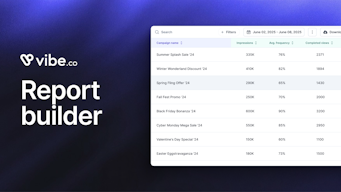7 Tips for TV Advertising for Small Businesses
TV advertising isn’t just for big brands—it’s a powerful tool that small businesses can use to reach their audience effectively.
It helps build credibility, connect with your target market, and stand out in both local and national spaces.
Did you know that TV ads are responsible for 71% of total advertising-generated profit and increase overall advertising effectiveness by 40%?
In this article, I’ll share seven practical tips to help you make the most of TV advertising for your small business.
Plus, I’ll introduce affordable platforms like Vibe that simplify creating impactful campaigns tailored to your goals.
Let’s dive in!
Why Should Small Businesses Invest in TV Advertising?
TV advertising is no longer out of reach for small businesses. Here’s why it’s worth considering:
Wide Audience Reach
- TV advertising connects with a broad audience, whether locally or nationally.
- Advanced targeting ensures ads reach relevant viewers and increases the likelihood of engagement and conversions.
Brand Awareness
- TV ads make brands memorable through a combination of visuals and audio.
- This medium helps consumers associate your brand with your products or services.
- Storytelling in ads and emotional resonance fosters long-term loyalty.
Improved Credibility
- TV is seen as a reliable source of information by many consumers.
- It strengthens your brand’s trustworthiness and professional image.
- Associations with reputable networks and channels boost your credibility.
Cost-Effective Options
- Advanced targeting optimizes your budget by focusing on key demographics.
- It allows your small businesses to compete with larger brands effectively.
By leveraging TV advertising, small businesses can create meaningful connections, enhance brand trust, and see measurable returns.
Now that you know the benefits, let’s explore 7 tips on how to make the most of your TV advertising for small businesses.
1. Tell a Compelling Story
TV advertising is all about storytelling. A great story captures your attention and makes your business memorable.
How to do it:
- It should focus on relatable narratives that resonate with your audience.
- This approach highlights how your product or service solves a problem or improves lives.
- You can ensure your messaging stays clear, visually appealing, and tied to your brand values.
Example: Dollar Shave Club
This subscription box service made a splash with a viral TV ad that was both entertaining and informative. The ad effectively highlighted the brand’s unique value while keeping the tone fun and memorable, showcasing how small businesses can create impactful TV campaigns.
Once you have your story, the next step is execution. A great TV ad doesn’t need to break the bank.
2. Keep Production Costs Low Without Compromising Quality
You don’t need a big-budget production to make a great TV ad.
Tips to save:
- It’s often effective to use in-house talent, like employees or satisfied customers, for authenticity.
- This can be achieved by creating professional-looking ads using tools like Vibe Studio, which lets you design ads in minutes.
- You can simplify visuals and messaging to focus on what matters most to your audience.
Pro Tip: Collaborate with local production teams or freelancers for cost-effective solutions.
Example: A bakery can feature its staff baking signature items, using close-ups of freshly made bread and happy customers, filmed on a budget.
Now that your ad is produced, you need to make sure your audience knows what to do next.
3. Be Clear with Your Call-to-Action (CTA)
A strong CTA makes it easy for your audience to take action. It connects your ad to the desired action, helping you turn viewers into customers.
Why CTAs Matter
- It bridges your ad and the action you want your audience to take.
- This ensures your advertising spend leads to measurable results.
- You can amplify your ad’s impact and drive more engagement with a clear CTA.
How to Make CTAs Effective
- It should use action-focused phrases like “Shop now” or “Scan to save.”
- This can include trackable elements like promo codes or dedicated URLs.
- Whether driving website traffic, collecting SMS leads, or encouraging calls, keep it short and easy to remember for better results.
Pro Tip: CTAs like “Use code SAVE20” or QR codes that link directly to an offer simplify the viewer's journey.
Example: A boutique could end its TV ad with “Scan the QR code to unlock 20% off your first purchase” to drive both engagement and sales.
With your CTA in place, it’s time to focus on reaching the right audience.
4. Leverage Data for Targeted Advertising
Targeting the right audience ensures your message lands where it matters most.
It ensures targeted TV advertising for small companies resonates with those most likely to engage, and platforms like Vibe make it easier than ever.
How Vibe Elevates TV Ad Targeting?
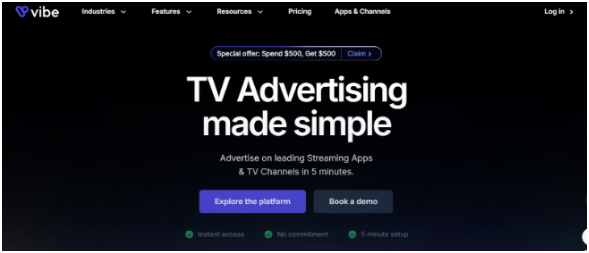
- Granular Demographic Targeting:
- Vibe lets you segment your audience based on factors like age, gender, income, and location.
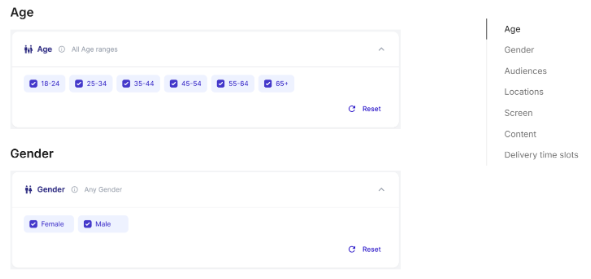
- This ensures your ads are highly relevant to the people who matter most to your business.
- Interest and Context Targeting:
- Vibe uses user behavior and preferences, such as interests in sports, pets, or philanthropy, to fine-tune your audience. A pet grooming service could run ads during pet-related content on CTV platforms.
- It allows ads to appear on specific apps, channels, or even during live sports for better engagement.
- Retargeting Power:
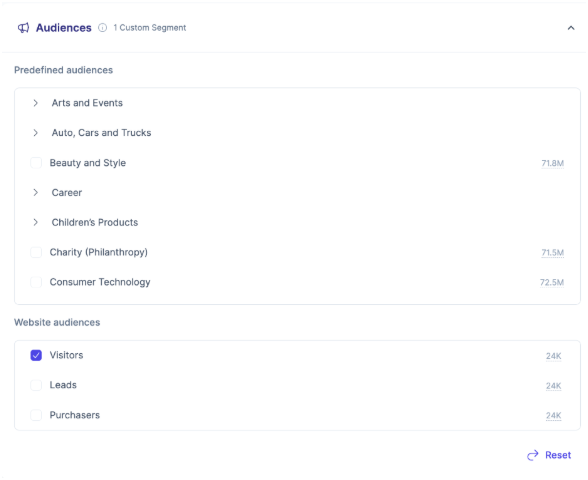
- Vibe enables you to reconnect with website visitors or app users directly on their TVs.
- This creates a seamless follow-up experience that keeps your brand top-of-mind.
- Wide Reach with Precision:
- Vibe provides access to over 120 million households across various regions.
- This gives you full control over who sees your ads and when they are displayed.
Vibe’s real-time performance tracking ensures your campaigns stay on target. With tools like multivariate testing and continuous reporting, you can fine-tune your ads on the go, optimizing for better engagement and budget efficiency.
By leveraging Vibe’s advanced targeting and measurement features, you can maximize your TV ad impact, delivering your message to the right audience at the right time.
Once you’ve honed your audience targeting, integrate digital strategies to enhance impact further.
5. Integrate TV and Digital Advertising
Combining TV ads with digital strategies creates a cohesive and impactful marketing approach.
Integrated campaigns ensure your audience engages with your message across multiple channels, reinforcing brand awareness and driving conversions.
Key Strategies for Integration
- Reinforce Your Message: You can run search and social media ads alongside TV campaigns to keep your brand visible across platforms, ensuring the message sticks.
- Capitalize on Second Screens: With viewers often browsing their phones while watching TV, your digital ads can engage them in real-time.
- Maintain Consistency: You should create seamless messaging across all platforms for a unified brand experience.
Tactics to Strengthen Integration
- Create Complementary Content:
- It helps extend TV ad themes through blogs, social media, or video content.
- This approach deepens audience engagement and reinforces your message.
- Use QR Codes
- It directs viewers to websites, special offers, or landing pages.
- This creates a seamless transition from TV to digital interaction.
- Sync TV and Digital Ads:
- This ensures consistent messaging across TV, social media, and search platforms.
- You can increase engagement by aligning your campaigns for maximum impact.
- Connected TV (CTV):
- It combines TV’s wide reach with precise digital ad targeting.
- This ensures ads reach audiences already consuming relevant content.
By blending TV and digital advertising, you can create campaigns that not only reach a broader audience but also keep your brand at the forefront of their minds across platforms.
After ensuring your campaigns are consistent, focus on building trust locally.
6. Optimize for Local Engagement
If your business serves local customers, leveraging your connection to the community is a powerful way to build trust and drive engagement.
Here’s how to maximize your local impact:
Highlight Local Connections
- It resonates with the community to showcase local landmarks, events, or cultural themes.
Local TV and Digital Marketing
- It’s effective to partner with local TV stations to reach nearby audiences.
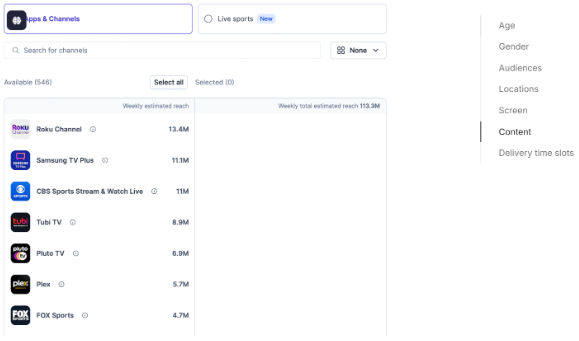
- This strategy works well when combined with digital ads, such as purchasing search ads around terms used in your TV ads, boosting visibility and response rates.
Geo-Targeting with Vibe
- The Vibe location targeting module allows you to reach specific neighborhoods, cities, or zip codes. For example, a home cleaning service can focus on high-income areas nearby.
- This includes tools like bulk upload for zip codes, making it easy to target precise areas for maximum impact.
Make Your Ads Memorable
- It helps to engage viewers with bold visuals, humor, or storytelling that reflects the local vibe.
- This approach, such as including a catchy jingle or relatable scenarios, makes your brand more memorable.
Showcase Your Community Involvement
- Your participation in community events, sponsorships, or charitable activities reinforces your local presence.
- This fosters goodwill and strengthens your reputation as a business that truly cares.
Track and Measure Success
- It’s important to set up tracking mechanisms, like unique phone numbers or promotional codes for different campaigns, to monitor results.
- This evaluation helps you refine your strategy by assessing KPIs like store traffic, social media engagement, and sales lift.
With Vibe, you can create affordable TV ads for small businesses that are highly effective with your local audience, and drive meaningful results.
7. Monitor Results and Iterate
Once your local engagement strategies are in place, the next step is to track your TV advertising performance and refine it over time. Effective measurement ensures that your campaigns stay relevant and impactful.
Measure Key Metrics
- It’s essential to track key performance indicators (KPIs) like store traffic, website visits, and sales. For example, a retail store could measure foot traffic after running a TV ad campaign.
- This includes traditional metrics such as Nielsen ratings and gross rating points (GRPs), which provide insights into reach and exposure frequency.
- Connected TV (CTV) advertising offers more precise performance metrics, such as impressions and click-through rates (CTR).
Use Vibe’s Real-Time Reporting
- This platform enables you to analyze campaign data instantly, helping you identify what’s working.
- Vibe’s multi-dimensional reporting tools allow you to break down performance by channels, audiences, time slots, or even device types.
- The integration with tools like Google Analytics and web pixel tracking ensures that every web visit, app install, or event is accounted for.
Test and Optimize
- You should experiment with different ad elements like messages, visuals, and air times to find what resonates best with your audience.
- This process is easier with A/B testing tools, such as those offered by Vibe, which help pinpoint the most effective strategies.
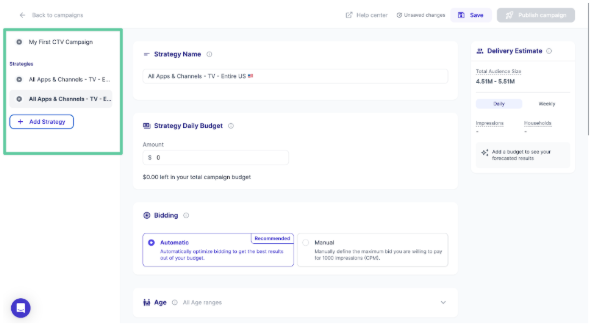
- It’s worth analyzing trends in in-app revenue and website activity to guide adjustments.
Leverage Advanced Attribution
- This can include using unique phone numbers, promotional codes, or custom landing pages to track how individual campaigns perform.
- Vibe’s attribution window feature lets you measure user actions from TV ads over a time frame of your choice, from 1 hour to 7 days.
Identify Patterns
- This involves regularly reviewing your campaign data to spot audience preferences, top-performing time slots, and the most engaging content types.
- You’ll also gain insights into regional or demographic-specific performance, ensuring localized strategies remain effective.
By monitoring results with precision and continuously iterating, you can fine-tune your TV advertising strategy to achieve even better outcomes.
Final Thoughts on TV Advertising for Small Business
TV advertising for your small business is not just about reaching your audience; it’s about forging genuine connections that build trust and credibility.
TV ads can set you apart from the competition and elevate your brand to new heights.
By following the actionable tips shared in this article—like crafting compelling stories, optimizing production costs, integrating digital strategies, and leveraging tools like Vibe—you can create campaigns that resonate with your target audience and drive meaningful engagement.
Platforms like Vibe make TV advertising accessible, offering advanced targeting, real-time analytics, and cost-effective solutions tailored to small businesses.
The world of TV advertising is evolving—don’t let your small business miss out on its potential!
Sign up today and get your first TV campaign live this week!
FAQs
- How much does TV advertising cost for small businesses?
Local ads cost $500–$1,500 per 30-second spot; Vibe offers affordable, targeted campaigns for small businesses. - What’s the ROI of combining TV and digital ads?
Combining TV and digital boosts ROI with higher traffic, ad recall, and sales by reinforcing each channel’s message. - Can small businesses target specific audiences with TV ads?
Yes, platforms like Vibe enable precise targeting by demographics, interests, and location for maximum impact.



